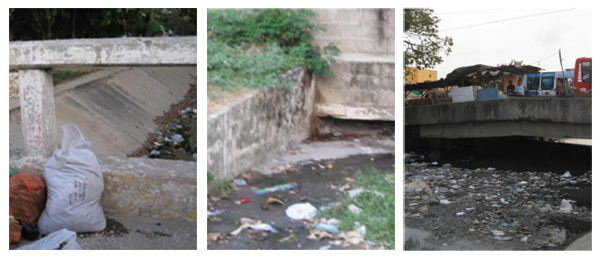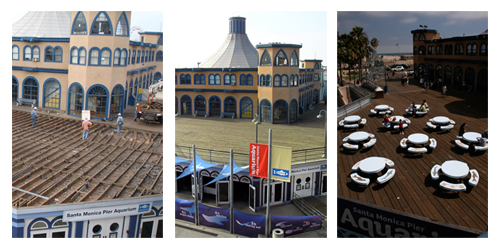Editor’s Note: In his final installment, Mark shares some more of his more memorable moments at Heal the Bay. Read the first A Wave of Memories, the second and the third.
Pop culture HtB’s involvement in popular culture has always been memorable. From “Baywatch” to KTLA’s Coastal Cleanup Day specials, we ended up in the more popular media in a lot of ways. Who could forget “The Solution,” a benefit CD with Bad Religion, Blink 182 and Black Eyed Peas contributing tracks? Evidently nearly everyone — it didn’t sell much. In the movies, we had our star turn in the thriller “Cellular” starring Kim Basinger, Jason Statham and Chris Evans. The kidnapping occurred on the pier during a Heal the Bay “benefit.” The band was supposed to be Incubus, but they had a conflict. HtB also showed up on an exploded bus billboard in “Speed” and a billboard in the John Cusack end-of –the-world saga “2012.” And I lost track of the number of fishbone HtB cameos in TV shows, from “thirtysomething” to “Hannah Montana” to “Modern Family.”
Malibu So much work. So much contention. Yet there is no way to walk away from fighting for that incredible coast. One memory: “Surf Doctor” Jeff Harris setting up a PSA shoot at Malibu Lagoon with Mel Gibson. The focus was on the impacts of Tapia’s summer discharges on Malibu Lagoon and Surfrider Beach. I have never seen anyone more agitated in my life. The guy was being stalked by the paparazzi — helicopter overhead and guys behind bushes. This was a real “Conspiracy Theory” They were out to invade his privacy. On the good news side: the Regional Board ordered Tapia’s discharge out of Malibu Creek from April through October, a major boon to Surfrider’s water quality because the lagoon berm breached less frequently.
Bravery I’ll always remember the courage of the volunteers that gave Heal the Bay everything they had even when they were fighting cancer. Jean Howell and Bob Hertz for Speakers Bureau. Joe Crocker, our first board treasurer. And of course, Dorothy.
Heroes Finally getting to see my idol, Jacques Cousteau, speak about saving the oceans. It was at a Marina del Rey chamber of commerce lunch. I took Mark E Pollock. It was surreal. Cousteau was wearing a powder-blue leisure suit and he stood on bright green Astroturf.
Science! I’ve always been partial to hiring very strong technical staff for the science and policy department. At one time, we had four doctorates (all UCLA Environmental Science and Engineering grads): myself, Mitzy Taggart, Craig Shuman and Shelley Luce. One Shelley story stands out. She was our science and policy director and she applied for the executive director position for the Santa Monica Bay Restoration Commission. I encouraged her to apply, but I was majorly concerned about losing such a valuable staff leader. The search committee included David Nahai and myself. We thought that the lead candidate, the highly experienced and extremely bright Nancy Sutley, would get the job in a heartbeat. After all she had recently left the state Water Board and Cal-EPA assistant secretary position. For some reason, Nancy wasn’t on her game during the interview, and Luce blew us away and got the job, where she’s flourished ever since. Sutley became Mayor Villaraigosa’s deputy Mayor for energy and environment and is now serving in the Obama adminsitration as the director of the President’s Council of Environmental Quality. It worked out for the best for all of us.
Smart propositions The fight for clean stormwater led to the successful Prop O (Los Angeles) and Measure Y (Santa Monica) funding measures. For the $500 million Prop O, I remember enviro groups and engineering firms pulling together under the leadership of Eric Garcetti and Jan Perry to make it happen. And the measure passed with over 76% of the vote! Now that was a fun celebration. Of course none of this would have happened without then Chief Legislative Analyst Ron Deaton’s decision to draw up the measure and go for it. The Measure V success was a little different. Craig Perkins convinced councilmembers like Bobby Shriver and Richard Bloom to push for the ongoing stormwater funding measure to reduce Bay runoff pollution and reduce flood risk and increase local water supply. The integrated approach and ongoing funding was great. The decision to make me campaign chair and plaster my ugly mug all over direct mail campaign pieces was really uncomfortable. Measure V only passed by 100 votes.
Fishy business During the height of the state and federal government’s natural resources damages lawsuit and the EPA’s Superfund enforcement actions, Heal the Bay undertook a fish contamination study on white croaker sold in local markets. Staffer James Alamillo led the effort along with chemist Rich Gossett, and we found that locally sold croaker was highly contaminated: one fish had a concentration of DDT over 30 parts per million! Talk about hazardous to your health. As a result, the study was used by the government in its enforcement case. Heck, the polluters even hired renowned UCSB ichthyologist Milton Love to redo our study. Since the contaminated croaker was largely found at Asian community markets, the Center for Biological Diversity actually sued those markets for supposedly knowingly selling croaker after the release of our study, a Prop 65 violation. We never predicted that litigious outcome, and we even got deposed on the case. Due to the threat of third party litigation, the local white croaker fishery ended up closing down.
No seismic shift Even an earthquake last year during a joint Heal the Bay-NRDC plea to the EPA office of water for more protective beach water quality standards couldn’t shake up the status quo in Washington D.C. The recently released draft criteria are weaker in many ways than the 1986 criteria despite the completion of dozens of studies in the beach water quality microbiology and epidemiology fields.
Ballona The fight for the future of Ballona has gone on for over 30 years. I remember the proposal from former councilwoman Pat Russell that would have destroyed the wetlands. In response to public uproar, Ruth Galanter got elected as the Save Ballona candidate. Poring over reams of Playa Vista EIR documents and design specifications for the freshwater treatment marsh was enormously time consuming and tedious. But the turning point was the environmental group debates leading to the state purchase. Areas A and B, the main wetland, were for sale and California had the bond money to buy it. Governor Davis’ days were running out because of the recall, so those in favor of the wetland purchase had to act fast. Environment Now hosted a series of meetings where the environmental community was split between buying the wetlands for the exorbitant price of $150 million, or opposing the purchase. The opposition didn’t want to pay more than $8-10M for the wetlands. The opponents were concerned that the extra revenues would enable Playa Vista to finish their development (Phase I was largely completed at that point.) After heated discussions, some of us (NRDC, Heal the Bay and Friends of Ballona to name a few) expressed our strong support for the purchase. I remember saying, “30 years from now, our kids won’t care what we paid for Ballona Wetlands. They’ll just care that they exist and they are preserved.” Luckily, this sentiment prevailed with Mary Nichols, the Secretary of Resources at the time.
The Staff of Life Watching Alix Hobbs grow from an 18-year-old receptionist to Programs Director to the Associate Director of the organization. Seeing Meredith McCarthy go from a Coastal Cleanup Day coordinator to the Programs Director and a force for greening L.A. Admiring the growth of a couple of UCSB Bren graduates into the water quality director, Kirsten James, and the coastal resources director, Sarah Sikich They’ve become environmental leaders locally and in Sacramento. Receptionist Gabriele Morgan greeting me every day, usually with a bad pun or a political joke. Callers to Heal the Bay have been heard the soothing tones of Gabriele’s voice for a long time. I’ll miss her voice, but not nearly as much as her biting commentary. Matt King, the best communication director in the business, constantly drawing on obscure film, news and sports references. Kudos to Vicki Wawerchak, who has progressed from being a Key to the Sea educator to ably running our Santa Monica Pier Aquarium, a community asset beloved by children and parents alike. I’m thankful for having a decade of Karin Hall as Heal the Bay’s No. 2 – helping to build the aquarium, keeping the board engaged and managing staff. Lee Myers sharing stories of the trials and tribulations of raising three kids while healing the Bay. And James Alamillo, Big Game James, my closest friend on staff, providing innovative ideas and providing a quick critique, and always there in an emergency or when you want to kill some time talking about sports. I will miss you guys!




